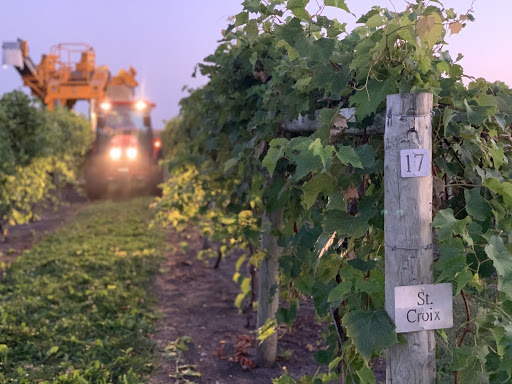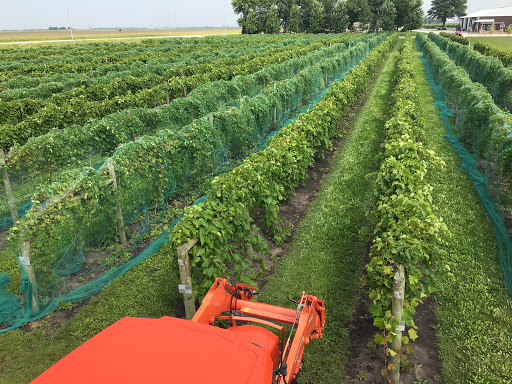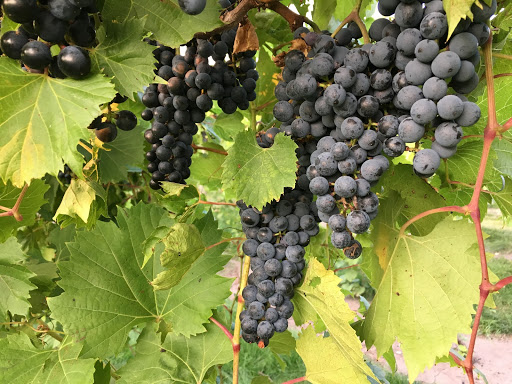Iowa winemakers squeezed by triple threat in 2020

A tractor navigates through grapevines at Soldier Creek Winery near Fort Dodge. Photo contributed by Anne Zwink of Soldier Creek Winery
Ever wonder what goes into that bottle of wine you’re drinking?
For many Iowa grape growers and wineries, the answer this year may be double the work with lesser results.
Iowa grape growers have been hit hard by areas of expanding severe and extreme drought, and for some, the Aug. 10 derecho knocked vines to the ground, bruising the grapes.
There are about 100 licensed wineries in the state and nearly 300 vineyards covering 1,300 acres, according to information from the Iowa Wine Growers Association. On average, Iowa vineyards produce about 4 tons of grapes per acre. With 1,300 acres, that would be about 5,400 tons, or about 10.4 million pounds of grapes per year.
According to the industry association, Iowans purchased nearly 4.7 million gallons of wine in 2019, down slightly from the previous year. About 300,000 gallons of that was Iowa wine, which represents a 6.4% market share of all wine sold in the state.
According to the Iowa Alcoholic Beverages Division, more than $8.2 million in wine tax was collected for the fiscal year that ended June 30, 2019, a 6.4% decrease from the prior fiscal year.
Nicole Eilers, marketing director of the Iowa Wine Growers Association, said grape production at Iowa vineyards is expected to be down in 2020, primarily because of the drought, which has caused grapes to shrivel on the vine.
She said decreased production may not be all bad because growers were buying fewer grapes because of reduced sales as a result of the coronavirus pandemic, which closed restaurants and bars.
Eilers said the price of Iowa-made wines doesn’t fluctuate much year to year, so lower volumes of production should not affect how much consumers pay.
Then came the derecho, which, depending on location, caused major damage.
Eilers said reduced production is a double-edged sword. For growers, it means less income coming in, but for wineries, the drier conditions mean more concentrated flavor.
“From the winery standpoint, hopefully we’ll see some fabulous wines come out this year,” said Eilers, whose family has one acre of grape vines near Logan, in western Iowa, north of Omaha, Neb.
There is another problem grape growers face during drought conditions.
“There’s a lot more bird damage that we’re seeing because there’s not as many food sources,” Eilers said. “We’re seeing a lot more bird damage earlier than in previous years. They’re just like vultures for the grapes this year.”
Anne Zwink, of Soldier Creek Winery in Fort Dodge, said the drier conditions will also lead to higher alcohol levels in Iowa wines this year.
“We’re going to more 14, 15, 16s, this year,” Zwink said referring to the alcohol contents of the wine produced. “But it also can affect the balance. It can affect the flavor.”
Zwink also said birds have been “horrendous this year, because there’s fewer bugs for them to eat, there’s not water anywhere for them to stay hydrated, so every afternoon we have flocks and flocks of starlings.”
She said the usual deterrent that is sprayed to keep birds away isn’t working this year because of the drought.
“This year, they don’t care,” Zwink said. “They are in the grapes and they are eating everything. So we’ve seen weight loss because of that, and we’ve seen whole clusters of grapes that are completely gone because the birds have eaten all the grapes off the cluster and all that is left is the stem.”
It takes about 3 pounds of grapes to make a bottle of wine, and it’s taking more clusters of grapes to make up that 3 pounds, Zwink said.
And then there’s the bruised grapes from the derecho.
“So, if it weren’t enough that the grapes are already dehydrated, now the bruised sides of the clusters are starting to shrivel up as well,” Zwink said.
Where the grapes go
Most of the grapes grown in Iowa stay in Iowa, but it’s not enough to support the state’s winemaking industry, causing some wineries to purchase grapes from other vineyards, often in other states.
While Soldier Creek has been able to purchase its grapes only from other Iowa vineyards, Zwink is uncertain if they will be able to continue that after this growing season, which ends this month.
Pandemic effects
Some wineries have also faced challenges from the coronavirus pandemic and restrictions put in place on social distancing to slow the virus’s spread.
Soldier Creek hasn’t had to close tasting rooms, although the number of customers has dropped. Zwink said she’s worried that number will continue to drop as the weather turns colder.
The winery has held indoor events with up to 100 people on Friday nights in the past, but Zwink expects that number to drastically drop as they put together plans for smaller events to keep people safe. “It’s scary,” she said.
Doug Bakker, owner of Madison County Winery in St. Charles, said he has been fortunate this year compared with some other wineries across the state. But he acknowledges the pandemic has made business difficult.
“It takes about double the work to get less than you did before,” Bakker said. “There’s so many things you have to do with spacing, trying to figure out how to bring people in because you can’t really do events. It seems like everything we do takes more time right now. It’s harder to do.”
Bakker said while he has experienced some decreased production as a result of the drought, his vineyard wasn’t hurt too bad from the Aug. 10 storm.
For Bakker, the pandemic may have had the biggest effect on his business.
Traffic to the tourism-focused county has dropped off in recent months.
“We’re seeing so little of that this year, and then the snowbirds, the people who come and go north and south, coming home this year we basically saw none,” Bakker said.
While tourism traffic came to a halt during the week, local traffic picked up on weekends.
“Because we’re outside the Polk County area, but an easy drive, we saw it pick up on the weekend because there’s not that many places to go in Des Moines, especially with an outdoor location where people can spread out,” Bakker said. “We have a big patio, we have lots of lawn where they take their own chairs and spread out. That’s worked. It’s not been bad on the weekends.”













